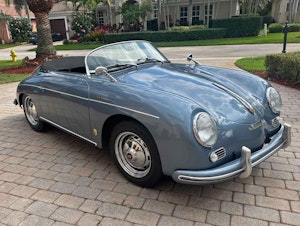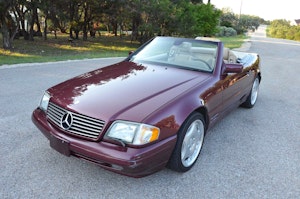Media | Articles
The truth behind the autonomous Mustang
A few months ago, a 1965 Ford Mustang made history. The silver pony car with blue stripes did not set a driving or race record. Nor sell for a record auction price. It drove itself. The feat occurred at the Goodwood Festival of Speed in England, the hillclimb that historic race cars from around the world come to conquer each year.
The vintage pony car completed the course eight times over the four days of the festival, which drew 55,000 spectators. A published video, showing the Mustang weaving and then brushing a hay bale, suggested this might be some kind of homebuilt project gone awry. It was anything but.
At the same event, the Roborace car navigated the Goodwood course without a driver at speeds up to 75 mph, but any comparisons are moot. The reasons behind the autonomous pony car’s construction had nothing to do with racing.
Not Ford’s idea
The builders did not package the electronic guts of a modern car inside its old body. This was pure 1965 Mustang, including its stock 289-cubic-inch V-8, automatic transmission, power steering, and drum brakes, and all their half-century-old responses.
Marketplace
Buy and sell classics with confidence
Notably, the autonomous Mustang was not a Ford publicity stunt, although it was instigated as a promotional effort. The Siemens name emblazoned on the doors was for the global automotive technology supplier. Juergen Maier, CEO of Siemens UK, approached England’s Cranfield University about a project to celebrate Goodwood’s 25th anniversary while also drawing attention to autonomous vehicle technology.
Cranfield had already been involved with autonomous vehicle research for major automakers. Maier suggested to Dr. James Brighton, who leads the school’s Motorsports Mechatronics program, the “crazy” idea of converting a vintage car to self-driving capability. Brighton accepted the challenge, which he felt could inspire future engineers and hatch new ideas while also being a fun project.
The team had just six weeks to transform a 53-year-old car into a viable autonomous demonstrator, and that was just the beginning of many challenges.
A brush with hay and glory
20181009202658)
Establishing a baseline for the old Mustang’s handling dynamics came first. The Goodwood course is just over a mile long but barely six-and-a-half feet wide and with plenty of twists and turns. There is little room for error, even at the relatively slow speeds the Mustang would travel. Many reports and online commenters focused on the way the car at times weaved.
The handling irregularities were not the fault of the electronics, though. The team had been asked by the video producers to show that the steering wheel turned on its own, so they programmed in some weaving—too much, it turns out. Then, before the first run, the power steering line began leaking. The artificial intelligence (AI) software tried to compensate but only made matters worse. Brighton, who was at the wheel, had to make corrections.
But the situation had a bright side.
“Brushing the bale was unfortunate and due in part to a failure of the cars original power steering system,” Brighton says. “But that really got the story going, and the reach has been enormous.”
How do you build an autonomous Mustang?
20181009202708)
The student team at Cranfield had just a month and a half to equip the Mustang with actuators to control the throttle, steering and brakes, and to also program the AI. Accelerometers and gyroscopes were installed to detect movement, and the wheels were fitted with speed sensors. The programming included a digital 3D model of the course, which Bentley Systems and Siemens had developed for Goodwood in 2017.
On each front fender, a GPS transmitter tracked the car’s position. Although the team also installed radar sensors, the system utilized only the GPS to navigate. There was a suspicion that radar might be confused by daily changes in the course, such as hay bales damaged or moved by a previous car crash.
Originally white, the Mustang was repainted silver for the Festival’s 25th anniversary.
“I’ll be back”
20181009202642)
Brighton calls the autonomous Mustang a success for its intended goal.
“It was a magnificent project for our students and staff alike, and while a long way from our autonomous driving research with Nissan, Jaguar Land Rover, and others, we still learned a great deal, and in only six weeks,” he says. “Given that Roborace took six months, 10 times the number of engineers, a bespoke bale-lined test track in France, and a car that was already autonomous, we feel proud of what we achieved in such a short time with no budget.”
Work on the Mustang will continue. “I have challenged my team to see how good they can make the car over the next 10 months with next year’s Motorsport Mechatronics students,” Brighton says.
Don’t try this at home… yet
20181009202749)
For now, the question of whether car enthusiasts will be able to convert classic models to autonomous driving in the future remains hypothetical. But we had to ask.
“It is possible to retrofit an older car with driver assistance systems that warn drivers,” says Huei Peng, Director of Mcity at the University of Michigan.
20181009202726)
20181009202738)
Mcity is a collaboration of industry, government, and academia to develop an ecosystem of connected and automated vehicles. The goal is for implementation, in Ann Arbor, Michigan, by 2021.
“Any driver-assistance functions with speed or steering control, or automated driving functions, will be challenging,” Peng says. “The reason is that older cars must be mechanically controlled for steering, throttle, and brakes. Reliably managing control through add-on actuators is not trivial, and is likely a custom job.”
Now that it’s been done, who knows? Perhaps in years to come, we will see driverless muscle cars in the Woodward Dream Cruise.
20181009202613)









